Blue Diamond Affair: The mystery of the stolen Saudi jewels
- Published
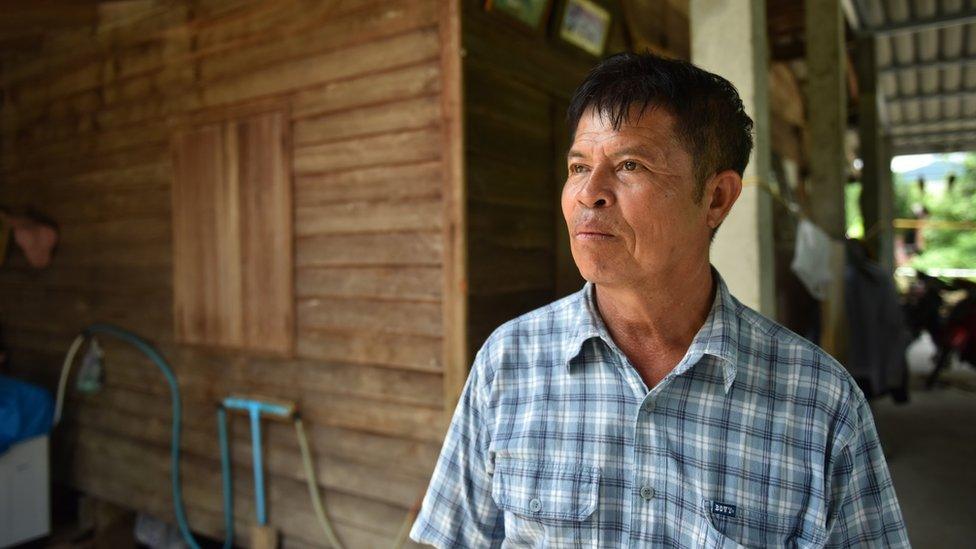
In 1989, Kriangkrai Techamong stole $20m of jewels and gems from his boss, a Saudi prince
The theft of precious jewels from a Saudi palace in 1989 set off a chain of killings and a diplomatic crisis that continues to this day. Now, in a rare interview, the man behind the theft tells his story.

The Saudi prince and his wife were away on holiday for three months, and the thief knew this was the time to strike.
Kriangkrai Techamong was running a significant risk. Stealing could be punished with amputation in Saudi Arabia, but Kriangkrai's was no ordinary theft - he had his eye on dozens of precious gems and jewels owned by his employer Prince Faisal, the eldest son of King Fahd of Saudi Arabia.
As a cleaner, Kriangkrai had come to know every corner of Prince Faisal's palace. And he had learned that three of the four safes containing the prince's jewels were regularly left unlocked. It was too good an opportunity to miss: he was struggling with gambling debt he had built up on the site where the palace workers lived, and this was a golden chance to flee the repressive country where he could no longer bear to live.
One evening, he made up an excuse to be inside the palace after dark. He waited until other staff had left, and sneaked into the prince's bedroom. He picked some jewels and stuck them to his body using duct tape. He also stored gems inside cleaning equipment, including vacuum bags.
By the end, he had taken almost 30kg (66lbs) of loot, valued at close to $20m. Among the pilfered items, Saudi officials would later say, were gold watches and several plump rubies.
That night, Kriangkrai hid the valuables all over the palace, in places he knew they would not be discovered. And then, over a month, he moved them and hid them in the middle of a large cargo delivery he was sending home to Thailand.
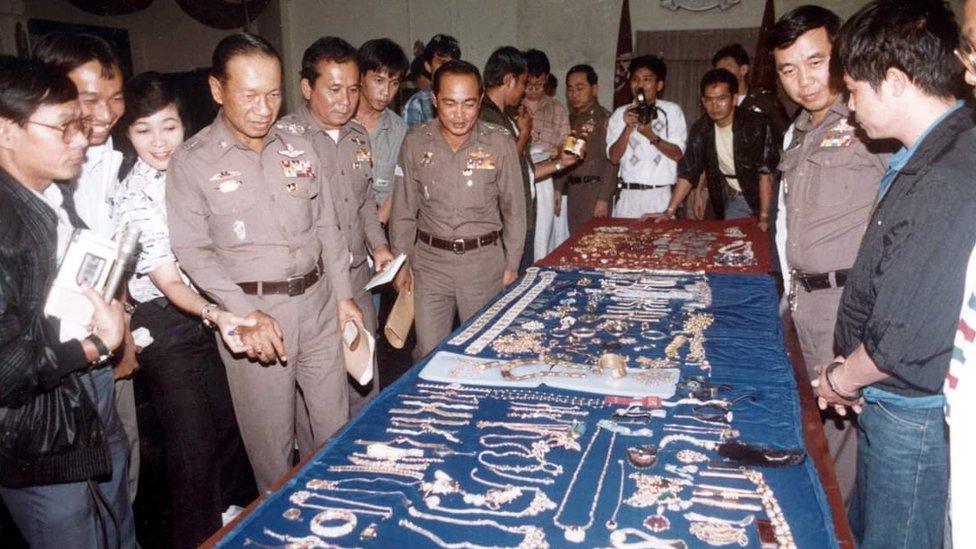
Thai police display some of the jewels they recovered, with Kriangkrai in handcuffs on the right
By the time the theft was discovered, Kriangkrai had already fled to his native Thailand, with his cargo leaving a few days before him. But the thief faced another challenge: how to get the stolen goods through Thai customs. All items imported from abroad had to be checked as they entered the country. But because he knew Thai officials could not resist a bribe, Kriangkrai stuffed an envelope with money and a note and put it in his cargo. The note said his cargo had pornographic material inside, and he would prefer it not to be searched.
His plan worked, but Kriangkrai could evade justice for only so long. In January 1990, he was arrested at his home in Thailand's northern Lampang province after the Thai police were alerted by their Saudi counterparts.
The gems and jewels - some of which he had kept, some of which he had sold - were retrieved soon afterwards. But some time in between their retrieval and their return to Riyadh, another crime occurred. Saudi officials said about 80% were missing, and many of those that had been returned were fake. Then, photographs started circulating of the wife of one senior Thai official wearing a necklace with an uncanny resemblance to one of the missing items.
It was the disappearance of one piece in particular that caused consternation, however: a rare 50-carat blue diamond the size of an egg.
The police here are bigger than the government itself... I feel I am fighting the devils
Only about 1 in 10,000 diamonds has a distinct body colour, says Alan Hart, the CEO of the Gemmological Association of Great Britain. Of those, just a tiny minority are blue, ensuring they are among the rarest and most valuable in the world. Their distinct colour comes from the faint traces of boron inside, an element present when the diamond was formed up to 600km (370 miles) below the Earth's surface.
Many of the blue diamonds in circulation today come from one source - the Cullinan mine near Pretoria in South Africa - but the origin story of the Saudi blue diamond is unclear and no known photographs of it exist.
The case might have ended with Kriangkrai jailed for under three years and Saudi Arabia decrying the disappearance of the prince's jewels, and the blue diamond in particular. Instead, the investigation took a bloody turn.
In early February 1990, two officials from the visa section of the Saudi embassy in Bangkok were driving towards the compound in the Thai capital. About a half a mile from their destination, their car was attacked by gunmen and both men were killed. At about the same time, another gunman entered the apartment of one of the men's colleagues and shot him dead.
Weeks afterwards, a Saudi businessman, Mohammad al-Ruwaili, was despatched to Bangkok to investigate what might have happened to the missing hoard. But he too was targeted - he was kidnapped and, while his body has never been found, he is widely believed to have been murdered.
Plenty of theories about the killings exist. According to a diplomatic note written in 2010, external by the deputy chief of mission in the US embassy in Bangkok, and later released by Wikileaks, the killings of the three diplomats "almost certainly were part of a Saudi feud with Hezbollah", the Lebanese Shia Muslim militant group.
But one Saudi official in particular was clear about who was responsible.

Mohammed Said Khoja, without his gun, displays evidence from the missing jewels case
Mohammed Said Khoja, a Saudi diplomat of 35 years' experience, was sent to Bangkok soon after the theft to oversee the investigation. After expecting to be in Thailand for only three months, he ended up staying for several years.
His role was technically not that of an ambassador, but of the lesser charge d'affaires. This was because Saudi Arabia had downgraded its relations with Thailand after the theft and murders, a move that saw the number of Thai workers in Saudi Arabia drop from more than 200,000 to only 15,000. This reportedly cost the Thai economy - so dependent on relatives sending money home - billions of dollars a year. Relations between the two countries are barely any better today.
Khoja, a stern moustachioed man, would give press interviews with his Smith & Wesson gun on the desk next to him, insisting that the Thai police were out to get him. His interviews, which would feature on the front pages of Thai newspapers, were unusually candid for a diplomat.
He would openly accuse the Thai police of stealing the recovered haul, and of killing the Saudi diplomats and businessman to cover up their own embezzlement. The men were killed, he said, because they had uncovered sensitive information about the theft. The police officer in charge of the investigation into the diplomats' killings was charged with Mohammad al-Ruwaili's disappearance, but the charges were later dropped.
"The police here are bigger than the government itself," Khoja told the New York Times in September 1994, external. "I am a Muslim, and I stay because I feel I am fighting the devils."

Read the best of our true-crime coverage
The Bombshell Bandit: How a well-dressed bank robber captivated the US
Death in Ice Valley: Who was the woman found dead in remote Norway?
Stolen by black magic: One of the boldest confidence tricks of all time
Iran's chain murders: "We understood that they wanted to kill us all"
The uncatchable: How Greece's most wanted man became a folk hero

This interview was one of many he gave in the same month, and it came soon after another killing linked to the theft.
Under growing pressure from Saudi Arabia, Thailand was looking for a resolution to the case. It had identified the man thought to have handled the hoard of gems and jewels after Kriangkrai returned to Thailand. The Thai gem dealer was believed to have sold the goods and replaced them with fakes, and he ended up becoming the key witness in the case.
But in July 1994, his wife and son disappeared and their bodies were later found in a Mercedes outside Bangkok. While there were signs of blunt force trauma on their corpses, a forensic report said they had died after their car was hit by a large truck. Khoja gave another round of interviews. "The forensic commander thinks we're stupid," he said in a press conference. "This was not an accident. They want to cover it up."
Khoja was right. It would later emerge that police tasked with finding the missing jewels had instead embezzled some of it, extorted the gem dealer, and murdered his wife and son. The police chief in charge of the original investigation, Chalor Kerdthes, ended up serving 20 years in prison.

Kriangkrai is nervous. It is 28 years since he was released from prison, 30 years since his daring theft, and now he is back living in north-west Thailand. Over several days, a team from the BBC's Thai service has been following one tip after another as to his whereabouts, and has finally traced him down to his modest home.
As his eyes dart from right to left, his paranoia is obvious. He repeatedly asks if our reporter is a police officer and then says we should step outside his home and speak instead in the middle of the rice paddy he keeps nearby. As he forms a path through the knee-high plants, he starts to talk. "What happened was like a nightmare to me," he says.
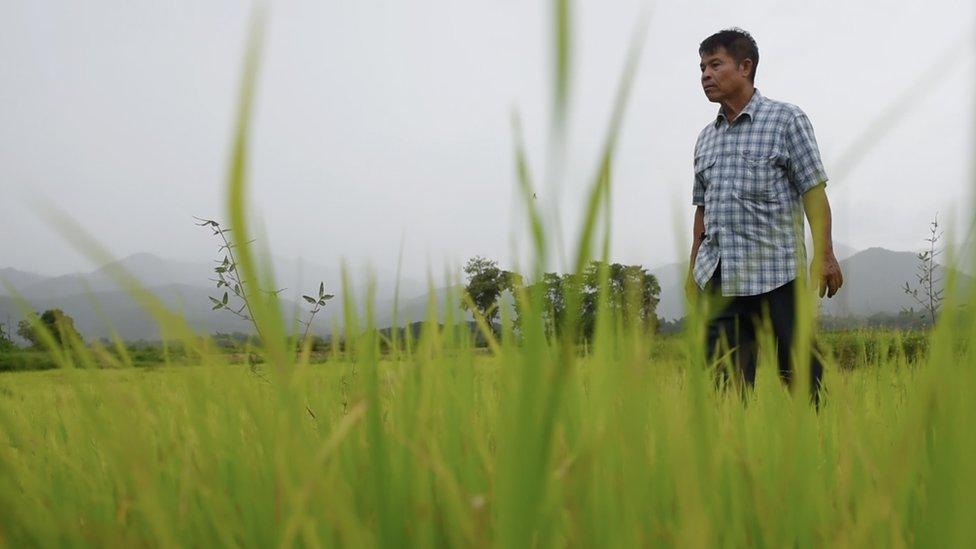
Kriangkrai in his paddy field in 2019
Over the following days, he gives one of his first detailed interviews since that theft, an act that led to the death of at least three people, and possibly many more. Even after all this time, he is still afraid he too could be killed for what he did. It's a feeling that has remained with him from the moment he was caught.
"At that time after I was arrested, I felt like I was out of my mind," he says. "I was panicking and paranoid all the time because of everything around me. The only thing on my mind was that I wouldn't make it out alive. I also thought there were many people who wanted to make me disappear or to kill me. I couldn't sleep at all for a week."
Kriangkrai insists he had no idea the crime he committed would turn out to be as significant as it did. He knew the gold was worth a lot of money, he says, but didn't appreciate the full value of the other items until after he had left prison. "When the police found me," he says, "I chose not to fight. I surrendered. I also returned the jewels and helped get back the items I sold. But if it wasn't for the involvement of powerful people in Thailand, this story wouldn't be so big."
As soon as he left prison - a five-year sentence reduced to only two years and seven months after he pleaded guilty - Kriangkrai changed his surname, to avoid bringing embarrassment to his son.
But he continued to feel guilty for what he did, and said his life after prison was full of "disappointment and unfortunate events". And so, in March 2016, he decided to become ordained as a Buddhist monk.
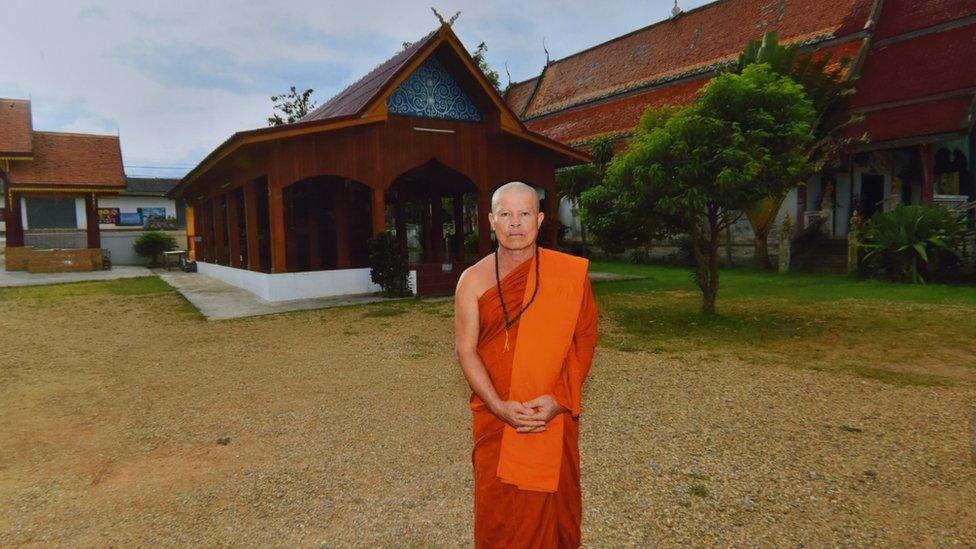
Kriangkrai stayed in a monastery for three years
Kriangkrai invited the media to his ordination ceremony, and said only a few words. "I want to be ordained for life to erase the curse of the Saudi diamond," he said, "and to dedicate my merit to the people ensnared by my karma, and those who died in all these past events. I want everyone's forgiveness for what I've done."
Kriangkrai chose a name for himself as a monk that translated as "he who is as strong as a diamond".
Among those present that day was Chalor Kerdthes, the police chief who had been jailed for his role in the killings of the gem dealer's family. While in prison, Thai media reported, he had continued to state he was not guilty, and had developed a skill as an Elvis impersonator. After his release, he too had decided to become a monk, but his time in the monastery did not last long.
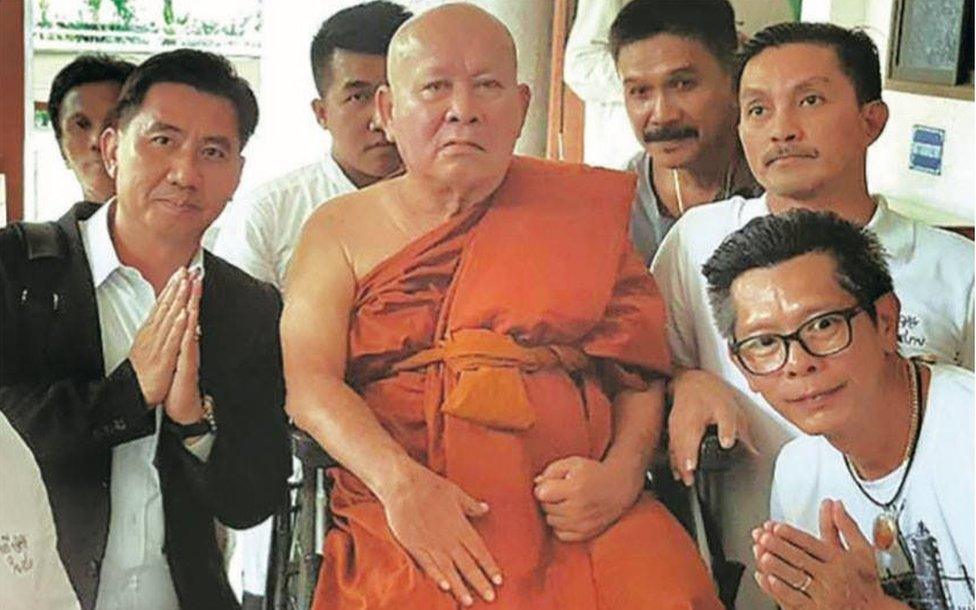
Chalor Kerdthes (C) in his time at the monastery
Chalor Kerdthes and Kriangkrai are the only people to have been jailed over the Blue Diamond Affair, as it is now known. In March, Thailand's Supreme Court cleared five former police officers over the disappearance and killing of the Saudi businessman, Mohammad al-Ruwaili.
While in the monastery, Kriangkrai still could not shake his past. People would seek him out and ask where he had hidden the blue diamond. He would tell them nothing, which led them to believe he had hidden it at home. The blue diamond has never been found.
Kriangkrai stayed in the monastery for only three years. "I couldn't be a monk for life since I still have my family that needs me," he says. Now aged 61, he takes whatever work he can find to survive - farming, tending rice paddies, maintenance.
"Now I live a simple life as a country man," Kriangkrai says inside his wooden home. "I don't have much money. It's only enough to survive and feed my family. I guess that for me is true happiness."